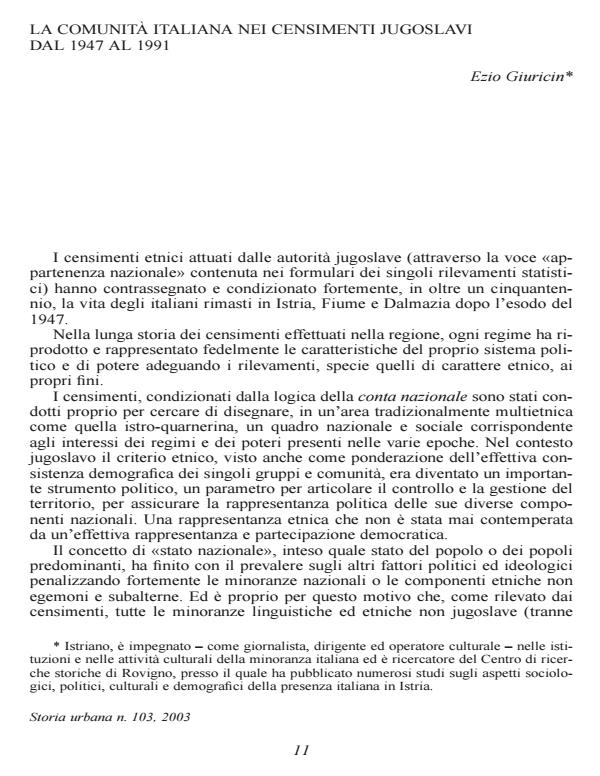La comunità italiana nei censimenti jugoslavi dal 1947 al 1991
Titolo Rivista STORIA URBANA
Autori/Curatori Ezio Giuricin
Anno di pubblicazione 2004 Fascicolo 2003/103
Lingua Italiano Numero pagine 19 P. Dimensione file 69 KB
DOI
Il DOI è il codice a barre della proprietà intellettuale: per saperne di più
clicca qui
Qui sotto puoi vedere in anteprima la prima pagina di questo articolo.
Se questo articolo ti interessa, lo puoi acquistare (e scaricare in formato pdf) seguendo le facili indicazioni per acquistare il download credit. Acquista Download Credits per scaricare questo Articolo in formato PDF

FrancoAngeli è membro della Publishers International Linking Association, Inc (PILA)associazione indipendente e non profit per facilitare (attraverso i servizi tecnologici implementati da CrossRef.org) l’accesso degli studiosi ai contenuti digitali nelle pubblicazioni professionali e scientifiche
In the essay Yugoslav censuses from 1945 to 1991 are studied, focusing especially on the data on the ethnic origin and the language spoken by the Italians that have remained in Istria, Fiume and Dalmatia after the 1947 Peace Treaty and the post-war exodus. The demographic and social changes occurring in that area after 1945 are examined in depth, outlining the upheavals and radical changes in the ethnic balance after World War II and until the dissolution of the Federative Republic of Yugoslavia. The author examines in detail the methodology used for each census, the overall national and interethnic demographic policy implemented at different times by the Yugoslav authorities. A general picture of the historical and social framework is also provided. Against this backdrop, the reasons for the massive population drop and ethnic assimilation of the Italians that had remained in Istria, Fiume and Dalmatia after the exodus are explained. In addition to providing useful hints on the demographic drop and, above all, the national, social and political marginalisation of the Italian community living in Yugoslavia between 1948 and 1981, the essay also points out the factors that determined the resurgence and revival of the Italian community in the early 90’s. Finally, the post-Yugoslav censuses carried out in Croatia and Slovenia in 2001 and 2002 respectively are presented, highlighting the shortcomings and contradictions of these national censuses. The alternative proposals put forward by the Italian community of Istria, Fiume and Dalmatia are illustrated to solve, once and for all, the blackmailing ethnic count.
Ezio Giuricin, La comunità italiana nei censimenti jugoslavi dal 1947 al 1991 in "STORIA URBANA " 103/2003, pp , DOI: